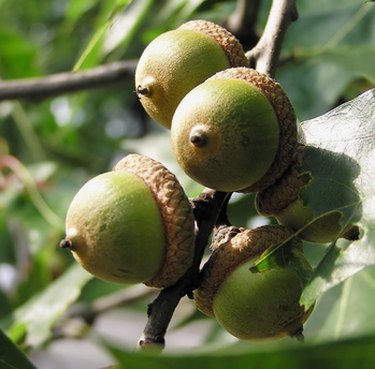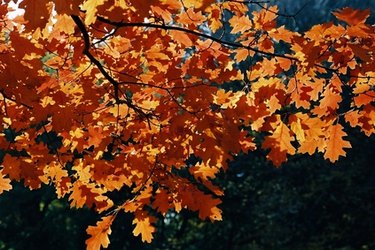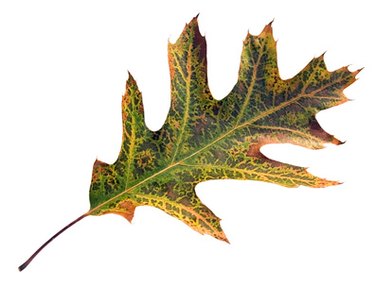
The live oak (Quercus virginiana) is Georgia's official state tree and symbolizes strength. More than 20 species of oak are native to Georgia, according to the University of Georgia School of Forest Resources Extension. Oak trees are hardwoods and members of the family Fagaceae and of the genus Quercus. The genus is subdivided into red oak and white oak categories. Most oak leaves are made up of a single blade with lobed, toothed or serrated edges, although there are exceptions. Identify the hardwood trees in your backyard, a nearby park or on your favorite hike to determine the variety of oaks in your area.
Step 1

Borrow a book on hardwood trees of Georgia or of the southern United States. Look at a website such as the University of Georgia's Significant Trees page (in the Resources section), which has a listing of oak tree sitings in various Georgia counties. Consult these resources before, during or after your identification field trip.
Video of the Day
Step 2
Look for acorns on a tree's lower branches or on the ground below the tree. All mature oak trees produce acorns and are a key indicator to determine if a hardwood tree is an oak. Acorns are ball shaped with woody or hairy caps.
Step 3

Examine a leaf from the oak tree you are identifying. Members of the red oak sub-genus have bristles at the end of their lobes or serrated edges, whereas white oak species do not. Use your guide references to identify oak trees down to species. For example, the scarlet oak (Quercus coccinea) tree has leaves with three major pointed lobes and several smaller striations, all of which have bristles. The leaf edges of swamp chestnut oak (Quercus michauxii) are lined with short teeth without bristles. Water oak (Quercus nigra), willow oak (Quercus phellos) and live oak (Quercus virginiana) leaves look different than other typical oak foliage. Water oaks have three small lobes on their leaf tips; willow oak leaves are narrow, oblong and have smooth edges; and live oak leaves are eliptical, leathery and are almost completely smooth.
Step 4
Examine the tree's acorn to help identify the oak species since not all acorns look alike. For example, the overcup oak (Quercus lyrata) produces acorns where the cap or cub has distinctive scales and encloses the majority of the nut. The scarlet oak's acorn has a short cap and characteristic rings on its bottom.
Step 5
Find out which trees are common in your area to help you identify oak species. For example, white oaks (Quercus alba) are common in the northern part of Georgia, but not so much in the south. Live oaks are common in the lower coastal plain.
Video of the Day
- Vanderbilt University: Comparison of Features of Oaks
- The University of Georgia: Native Plants for Georgia
- University of Georgia School of Forest Resources Extension: Native Tree Families and Species of Georgia
- Virginia Tech, College of Natural Resources and Environment: Leaves
- The University of Georgia: Significant Trees of Georgia, Index of Trees